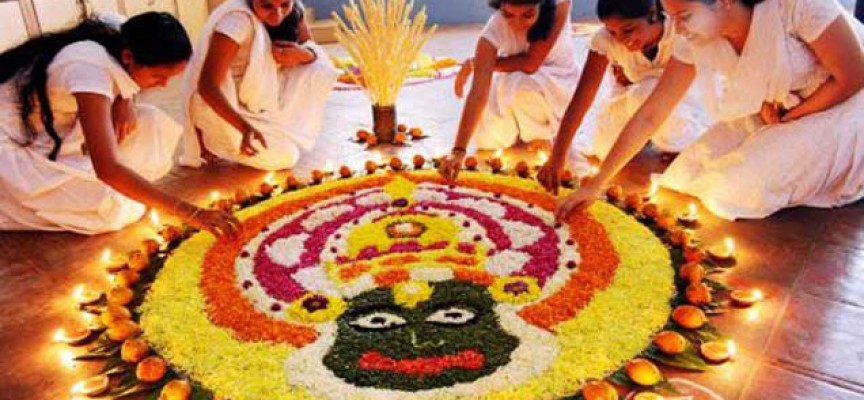Onam is one the most anticipated festivals celebrated with much fanfare and merriment by the people in Kerala, irrespective of one’s caste or creed.
Usually coinciding with crop harvests in the region, the story behind how the festival came into being goes all the way back to Vedic and Puranic ages. There are several interesting legends behind the origin of Onam. The mythical King Mahabali, considered to be one of the greatest kings to have ever ruled Kerala, is believed to ascend to Earth from the netherworld to meet his subjects once every year.
It is his homecoming that is celebrated as the festival of Onam, as we know it today. The king remains quite popular in Kerala even to this day, as testified by the folk song, Maaveli Naadu Vannidum Kaalam (When Maveli, our King, ruled the land), that speaks of his reign being one where all were equal.
The Legend of King Mahabali
It is believed that there once lived a wise and generous asura (demon) king, Mahabali. He was highly regarded by his subjects and everybody was happy in in his kingdom.

Gods felt challenged with the growing popularity of Mahabali. They seeked help from Lord Vishnu who was worshiped by King Mahabali. Lord Vishnu took the avatar of a poor and dwarf Brahmin, called Vamana and came to the kingdom of Mahabali just after his morning prayers, when the King gave boons to the Brahmin.
The disguised Lord Vishnu asked for as much land as could be covered by his three steps. The King made a promise to do so. Suddenly, Vamana increased to a massive size. With his one step he covered the whole of the sky and with the other he covered the whole of earth. He then asked for a place to put his third step. King realised that the boy was no ordinary Brahmin and asked Vamana to to put his third step on his head.
The boy did so, pushing Mahabali in the nether world, the patala. Lord Vishnu was pleased with King Mahabali generosity and granted him a boon. Deeply attached with his people, the King said he would like to visit Kerala and his people every year. Lord Vishnu was pleased to grant the request.
It is this homecoming of King Mahabali that is celebrated as Onam every year.
Another Version of the Legend
There is another legend related to King Mahabali but with a different view point. It says, though, King Mahabali was a wise and judicious ruler, he was also very egoistic. He was a devout worshiper of Lord Vishnu and the Lord wanted to redeem his devotee of the sin.
Lord Vishnu took the avatar of a poor and dwarf Brahmin, called Vamana and asked for a piece of land from the King. The egoistic King said he may have as much land as he wanted. Vamana replied that he want only as much land as could be covered by his three steps. To this the King laughed and made a promised to do so.
The Brahmin boy increased in cosmic proportions. With his one step he covered the whole of sky and with the other, the whole of the earth. King Mahabali realised that the boy was God himself who came on a purpose and offered his head to place his third step. This pushed the king to the nether world, patala. It proved to be a blessing for the King as it released him from the cycle of life and death. This is why, Onam is celebrated by wearing new clothes. People resolve to lead a new life of honesty, piousness, love, and humility. Different rituals are practised even today that celebrate the reign of the king, which is considered to be a golden era in the history of Kerala.
Interestingly, despite the role that Vamana had in the banishment of Mahabali, he is not written off as a villainous character in the state.
In fact, one of the major instalments of the festivities includes statues of both figures. These are circulated in homes of people as a representation of the king’s visit as well as the god’s.
While the statue of Mahabali is known as Onathappan, Vamana’s form goes by the name of Thrikkarayappan, the lord of the land covered in three paces. And both make way into the floral arrangement of Pookalam on Pooradam, the eighth day of Onam.
And as the month of Chingam falls by year after year, the people of Kerala continue to await the visit of their beloved king and seek his blessings
The Legend of Vanishing Boy
It is said that once, about 10 kilometers up the river Pampa from Aranmulla, the head of the Katoor Mana, a Nambudiri family, had a bath in the river. He said his prayers and waited to feed a poor man to complete his ritual. He waited for long but nobody came. Tired of waiting, the Brahmin closed his eyes and began to pray to Lord Krishna. As soon he opened his eyes, he saw a small boy in tatters before him. The devout Brahmin gave a bath to the boy, a set of clothes and a sumptuous meal.
To the surprise of the Brahmin. the boy vanished as soon as he finished his meal. He looked for the boy and spotted him near Aranmulla Temple. But, the boy disappeared again.
The Brahmin came to the conclusion that he was no ordinary boy and was God himself. From then on the Brahmin brought food to Aranmulla Temple every year during Onam.
The Legend of Boat Palliodam
The story goes that several years ago some people were traveling in the boat called Palliodam when all of a sudden the boat got stuck in the bend in the river. The oarsmen tried to move it but were unsuccessful. The spiritual head, Bhattathiripad who was boarding the same boat Palliyodam, thought that it was a bad omen as the boat was laden with food. He came to river bank to seek help and saw a hut by a dim light that was glowing. He decided to visit the hut and ask for help.
When Bhattathiripad went close to the hut he saw a poor widow weeping and some children sleeping besides her. The woman told Bhattathiripad that her children slept off hungry and she has no food to feed them. Bhattathiripad was moved by her pathetic state. He went to the boat Palliyodam and brought food for the family. When the family became happy with the food, boat Palliodam could be easily maneuvered to the main course of river again.
From then on began the tradition of feeding one poor person on the day of Onam.
————–
Must Read : Onam Celebrations in Delhi
Must Read : Onam : How Kerala Clebrates the 10- day long Harvest Festival









